Advertisements
Advertisements
प्रश्न
What are the methods used by plants to get rid of excretory products?
उत्तर १
Plants can get rid of excess of water by transpiration. Waste materials may be stored in the cell vacuoles or as gum and resin, especially in old xylem. It is also stored in the leaves that later fall off.
उत्तर २
- Photosynthetic and respiratory wastes such as oxygen and carbon dioxide are used for respiration and photosynthesis. Any excess is expelled through the stomata.
- Excess water is removed through the process of transpiration.
- Waste products may be stored in leaves, bark, or other parts of the plant, which later fall off, removing the waste from metabolically active areas.
- In some plants, metabolic by-products are stored as crystals.
- Several substances, such as resins, tannins, and alkaloids, such as morphine and quinine, are also plant wastes, although they benefit humans.
APPEARS IN
संबंधित प्रश्न
Describe the structure and functioning of nephrons.
The Biological/technical term for The removal of nitrogenous wastes from the body
The diagram given below shows the male urinogenital system of a human being. Study the diagram and answer the questions that follow:

(i) Label the parts numbered 1 to 8.
(ii) Name the corresponding structure of part (4) in female reproductive system.
(iii) What is the role of part 7?
The given diagram represents a nephron and its blood supply. Study the diagram and answer the following questions:

(i) Label parts 1, 2, 3 and 4.
(ii) State the reason for the high hydrostatic pressure in the glomerulus.
(iii) Name the blood vessel which contains the least amount of urea in this diagram.
(iv) Name the two main stages of urine formation.
(v) Name the part of the nephron which lies in the renal medulla.
Differentiate between the following pair on the basis of what is indicated in the bracket.
Ureter and Urethra [function]
Name the procedure used in the working of artificial kidney.
Define excretion. Name the excretory unit of a kidney.
What job is done by the kidneys?
Why do some people need to use a dialysis machine? What does the machine do?
Describe the mechanism of urine formation in human excretory system. Draw a labelled diagram to illustrate your answer.
Fill in the blank :
Nitrogenous wastes in the urine are in the form of urea and .....................
Write True (T) or False (F) for the following statement. Rewrite the false statement in the correct form.
Excess sugar in the blood is a symptom of diabetes.
Differentiate between
excretion and transpiration
Answer the following in short.
What is excretion?
Answer the following in short.
List five waste products of plants.
If you donate one kidney to a needy patient, would it cause any harm to you? Give reason.
Differentiate between the following pairs of term :
Renal pelvis and renal papilla
Given below is a simplified diagram of the human kidney cut open longitudinally. Answer the questions that follow.
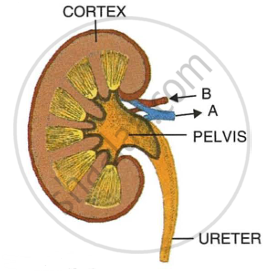 |
- Define excretion.
- Why does the cortex of the kidney show a dotted appearance?
- Why does the medulla of the kidney show a striped appearance?
- Write two differences in the composition of the blood flowing through the blood vessels 'A' and 'B'.
Choose the correct answer:
Composition of extracellular fluid is regulated by ___________
Given below is a diagram of a human kidney, cut open longitudinally. Answer the following:
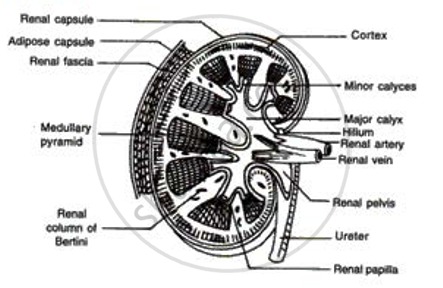
(i) Give definition of excretion.
(ii) Name the unit of kidney.
(iii) Why does the cortex of kidney show dotted appearance?
(iv) List the functions of the kidney.
Look at the figure given below. It is a section of human kidney as seen from the front.
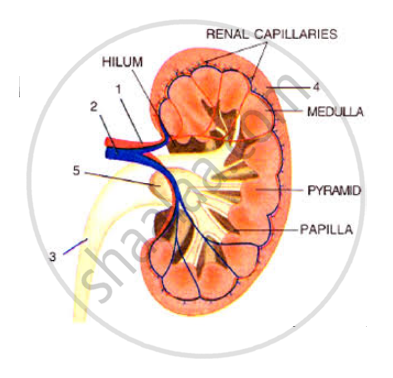
Which area/part (give its name and number given on the diagram) which contains the following:
(i) Malpighian capsule
(ii) The pyramids
(iii) Freshly collected urine
The following diagram represents a mammalian kidney tubule (nephron) and its blood supply.
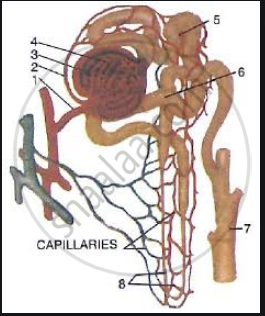
Parts indicated by the guidelines 1to 8 are as follows:
1. Afferent arteriole from renal artery
2. Efferent arteriole
3. Bowman's capsule
4. Glomerulus
5. Proximal convoluted tubule with blood capillaries
6. Distal convoluted tubule with blood capillaries
7. Collecting tubule
8. U-shaped loop of Henle
Study the diagram and answer the question that follow:
Which structure contains the lowest concentration of urea?
Study the diagram given alongside and then answer the question that follow:
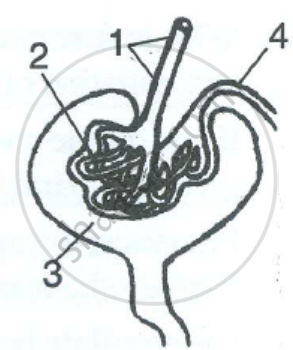
What is the technical term given to the process occurring in 2 and 3? Briefly describe the process.
Answer the following question:
Explain the human excretory system with the help of a suitable diagram.
Differentiate between:
Renal cortex and Renal medulla.
The diagram below represents a mammalian kidney tubule (nephron) and its blood supply. Parts indicated by the guidelines 1 to 8 are as follows:
1. U-shaped loop of Henle
2. Proximal convoluted tubule with blood capillaries
3. Bowman’s capsule
4. Afferent arteriole from the renal artery
5. Glomerulus
6. Venule to the renal vein
7. Collecting tubule
8. Distal convoluted tubule with blood capillaries Study the diagram and answer the following questions in each case:
(i) Where does ultrafiltration take place?
(ii) Which structure contains the lowest concentration of urea?
(iii) Which structure contains the highest concentration of urea?
(iv) Which structure contains the lowest concentration of glucose?
(v) Where is the most water reabsorbed?
Name the Following
The structural and functional units of kidney
Name the Following
The branch of renal artery which enters into Bowman’s capsule.
Give Technical Term:
The organ in man concerned with maintaining water balance in the body.
State the Location: Medulla of Kidney
Write the functional activity of the following structure: Henle’s loop
Choose the correct option.
Specific gravity of urine would _______ if level of ADH increases.
Choose the correct option.
The part of nephron which absorbs glucose and amino acid is ______.
Complete the diagram/chart with correct labels/ information. Write the conceptual details regarding it.
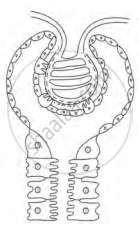
Elimination of nitrogenous wastes in the form of uric acid takes place in ____________.
Among the following animals, the best conserver of water is ______.
In a person the tubule part of the nephron is not functioning at all. What will its effect be on urine formation?
Give reason:
Excretion is a necessary process of our body.
